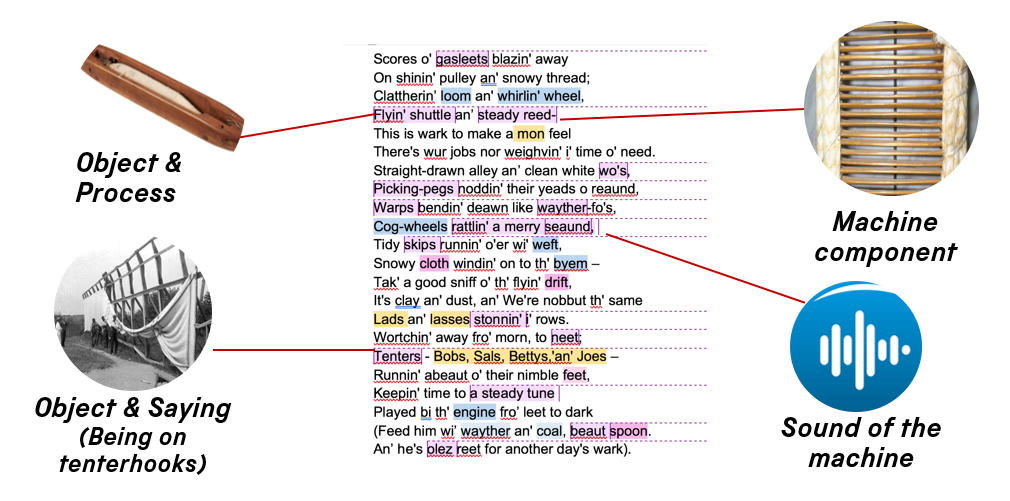Congruence Engine investigations

Connecting Industrial Folk Songs with mining and textile collections
Short summary
Folk songs practitioners and scholars can provide invaluable insights to unlock the dialect-rich terminology and the local knowledge of textile and mining workers which is embedded in industrial folk songs. However, the intangible, performative nature of this knowledge and the predominantly non-institutional nature of folk songs sources and archives have limited their use in historical research and museum practice.
This investigation explored how we can use annotation tools to identify connecting tissues to link Industrial folk songs to mining and textile collection, and integrate the expert knowledge of folk songs communities into the linkages.
By working with OCR-generated transcriptions of two industrial folk songs anthologies, the investigation team worked with the folk song expert Jennifer Reid to annotate a collection of textile and mining songs, capturing her knowledge through video conversations and textual annotations. The list of industrial terms and knowledge extracted from the investigation demonstrated the potential for such sources to enrich collection interpretation as well as ontology research in the field of Industrial History. In the final phase of the investigation, the research team undertook a preliminary experimental set-up for using Label Studio platform to expand this work.
Despite showing the potential of text-based annotation tools, the investigation highlighted the need to embed audio-visual methods in the annotation process, to preserve the immediacy of the knowledge exchange and engage with the sonic nature of this material.
Research questions
1) How can we connect industrial folk songs to mining and textile connections? What connecting tissues can we identify for such linkages? What tools would be the most suitable for extracting and creating such linkages?
2) How can we use annotation tools to integrate expert knowledge about folk songs into the linkages?
3) How does the performative, dynamic and participatory nature of folk songs challenge the traditional concept of ‘museum object’? What are the new assumptions that need to be taken into consideration to collect and link these sources to other heritage collections?
People
Stefania Zardini Lacedelli:
Conceptualization, Methodology, Investigation, Data Curation, Project administration, Visualization, Writing
Daniel Belteki:
Conceptualization, Methodology, Investigation, Data Curation, Visualization, Writing
Jennifer Reid:
Investigation, Data Curation, Writing
Kaspar Beelen:
Methodology, Software
Kunika Kono:
Methodology, Software
Data sources (used or developed)
-
The anthology Folk Songs & Ballads of Lancashire edited by Harry and Leslie Boardman. A selection of 7 songs specifically dedicated to the work in the mills and the cotton industry was used in the investigation.
-
The anthology Come all ye bold miners: Ballads and Songs of the Coalfields (1952 & 1978), edited by A. L. Lloyd. The songs are related to mining work and culture, reflecting Lloyd’s aim to present the mining folk songs heritage.
Investigation methods/ tools/ code/ software (used or developed)
Data Preparation
- OCR (ABBYY Finereader)
- NER (spaCy)
- manual entity extraction
Annotation
- MS Word (using the ‘style’ and ‘comments’ function. All annotated data was then extracted and converted into JSON format for future use)
- MS Teams (video recording of Teams meeting with Jennifer Reid expanding the written-based annotations with comments and singing)
- Label Studio (initial experimental set-up using the annotation data generated)
Outputs
-
OCR transcriptions of the two folk songs anthologies and initial spaCy runs for NER in OCR captured texts
-
Onodo Visualization and a digital narrative on Yarn to visualize the connections enclosed in a folk song
-
A selection of annotated folk songs from the two anthologies used for an initial experimental set-up on Label Studio
-
A list of extracted industrial terms that can enrich existing industrial taxonomies
-
A blog post and a short film dedicated to the investigation, made available as part of the Congruence Engine exhibit at the Discovery Museum in Newcastle opened in October 2023
Licence
This work is licensed under a Creative Commons Attribution 4.0 License - CC BY 4.0.